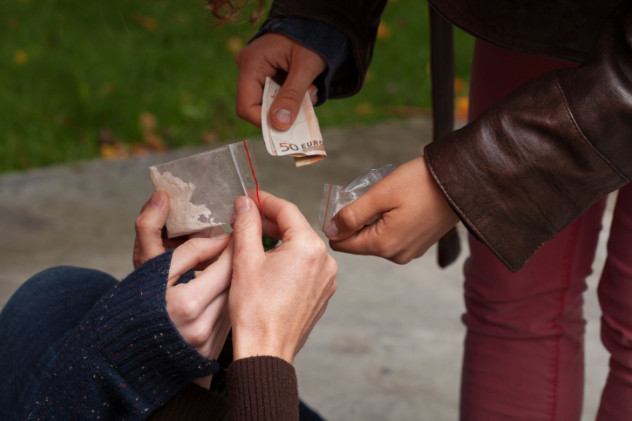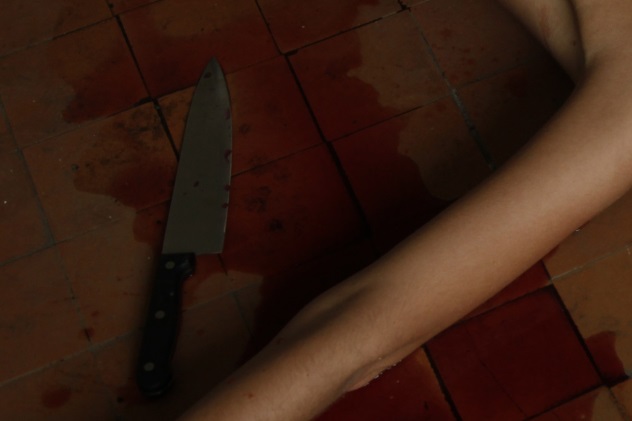 Miscellaneous
Miscellaneous  Miscellaneous
Miscellaneous  Animals
Animals 10 Strange Attempts to Smuggle Animals
 Travel
Travel 10 Natural Rock Formations That Will Make You Do a Double Take
 Movies and TV
Movies and TV 10 Actors Hidden in Your Favorite Movies
 Our World
Our World 10 Science Facts That Will Change How You Look at the World
 Pop Culture
Pop Culture 10 Incredible Female Comic Book Artists
 Crime
Crime 10 Terrifying Serial Killers from Centuries Ago
 Technology
Technology 10 Hilariously Over-Engineered Solutions to Simple Problems
 Miscellaneous
Miscellaneous 10 Ironic News Stories Straight out of an Alanis Morissette Song
 Politics
Politics 10 Lesser-Known Far-Right Groups of the 21st Century
 Miscellaneous
Miscellaneous 10 Undeniable Signs That People’s Views of Mushrooms Are Changing
 Animals
Animals 10 Strange Attempts to Smuggle Animals
 Travel
Travel 10 Natural Rock Formations That Will Make You Do a Double Take
Who's Behind Listverse?

Jamie Frater
Head Editor
Jamie founded Listverse due to an insatiable desire to share fascinating, obscure, and bizarre facts. He has been a guest speaker on numerous national radio and television stations and is a five time published author.
More About Us Movies and TV
Movies and TV 10 Actors Hidden in Your Favorite Movies
 Our World
Our World 10 Science Facts That Will Change How You Look at the World
 Pop Culture
Pop Culture 10 Incredible Female Comic Book Artists
 Crime
Crime 10 Terrifying Serial Killers from Centuries Ago
 Technology
Technology 10 Hilariously Over-Engineered Solutions to Simple Problems
 Miscellaneous
Miscellaneous 10 Ironic News Stories Straight out of an Alanis Morissette Song
 Politics
Politics 10 Lesser-Known Far-Right Groups of the 21st Century
10 People Who Were Wrongly Convicted Of Nonexistent Crimes
It’s a sad event when an innocent person is wrongly convicted of a crime they did not commit. However, it’s especially tragic when the alleged crime never even occurred in the first place. If an innocent person is charged with a crime that someone else committed, there’s always a chance they will have their name cleared once the real perpetrator is caught, but exoneration can become a lot more difficult when no one else is to blame. Because of false accusations or serious misinterpretation of the facts, the following people wound up being punished for a nonexistent crime.
10Victoria Bell Banks

Infanticide is a truly heinous crime deserving the most severe punishment, but it generally requires the infant to have once existed. Those who prosecuted Victoria Bell Banks, however, begged to differ. In May 1999, Banks was incarcerated at the Choctaw County Jail in Butler, Alabama when she requested a furlough, claiming to be pregnant. She was examined by a pair of doctors, who disagreed about her condition—one thought they could detect a fetal heartbeat, while the other insisted she was not pregnant. Nevertheless, Banks was granted her furlough.
Three months later, she was questioned by authorities, who noticed she was no longer pregnant and wanted to know what became of her child. Banks eventually confessed to murdering the baby after it was born and disposing of the remains. She further implicated her husband and her sister, who both confessed to the crime. In order to avoid the death penalty, the trio pleaded guilty to manslaughter and received 15-year sentences.
The convictions were highly controversial. It was eventually revealed that all three suspects had low IQs and had been coerced into confessing to the crime and entering their guilty pleas. Furthermore, it was likely that Victoria fabricated her pregnancy as a ploy to get released from jail. In fact, she had actually received a tubal ligation four years beforehand. Her alleged accomplices were eventually released from prison after this evidence came to light, but Banks never attempted to appeal her conviction, so she remains incarcerated for the death of a nonexistent child.
9Louise Butler And George Yelder

In 1928, Louise Butler lived in Lowndes County, Alabama with her two children and two nieces. Butler had garnered the attention of a married neighbor named George Yelder but soon became jealous of the attention he lavished upon her 14-year-old niece, Topsy Warren.
One night in April, Butler decided to confront Warren and allegedly beat her. When Warren disappeared shortly thereafter, the community suspected foul play. During the investigation, Butler’s daughter, Julia, and her second niece, Anne-Mary, informed the authorities that Butler had murdered Warren and Yelder had dismembered the remains before tossing them into a river.
Butler was arrested and confessed to Warren’s murder, and both she and Yelder were indicted for the crime. However, Butler quickly recanted her confession, and Yelder’s family claimed he was with them on the night of the alleged murder. In spite of these discrepancies, Julia and Anne-Mary provided such vivid testimony about the crime that both were found guilty and sentenced to life imprisonment.
Less than a week after the verdicts, the community received some shocking news: Topsy Warren was still alive and living with relatives in a nearby town. When confronted, Julia and Anne-Mary claimed that a man who held a grudge against Yelder had coached them into fabricating their story about Warren’s murder. Butler and Yelder were granted full pardons and released from prison.
8Bernard Baran

The 1980s were plagued by hysteria as many daycare providers were charged with sexual abuse against children and performing satanic rituals in their presence. Most of these charges turned out to be false. The first person to be officially convicted was Bernard Baran, a 19-year-old teacher’s aide at the Early Childhood Development Center (ECDC) in Pittsfield, Massachusetts.
In September 1984, allegations of sexual abuse at another daycare center in nearby Malden hit the news. Shortly thereafter, the parents of a child attending the ECDC expressed their displeasure at the school’s employment of Baran, who is homosexual. When the school refused to fire Baran, the parents removed their child from its care, and on October 5, they went to the police and accused Baran of sexually abusing their child.
The charges were clearly ludicrous—the child had not even attended school on the day they claimed the abuse occurred. As drug addicts and police informants, the parents weren’t the most credible witnesses, either. Nevertheless, once word of this allegation spread, five more children came forward to accuse Baran of molesting them. One month later, Baran was indicted on six counts of rape and six counts of indecent assault.
After being sentenced to two concurrent life terms, Baran languished in prison for nearly two decades until a new legal team took on his case and noticed some odd discrepancies. Like most of the “sex abuse hysteria” cases, all the victimized children denied being molested at first. They only made their accusations against Baran after being coached by parents and therapists, and their stories were filled with inconsistencies. After his new legal team lodged allegations of misconduct against the prosecution at his original trial, Baran was granted a conditional release in 2006. All charges against him were dropped three years later.
7Sonia Cacy

One of the most controversial executions of all time occurred in Texas in 2004, when Cameron Todd Willingham was put to death for burning down his home, murdering his three children in the process. However, a reexamination of the case determined that the fire was likely an accident.
In 1991, a Texas woman named Sonia Cacy found herself at the center of another controversial arson case. On November 10, Cacy’s Fort Stockton home burned to the ground, and her 76-year-old uncle, Bill Richardson, was killed. Cacy managed to escape, but she claimed she could not reach her uncle. After traces of gasoline were found on Richardson’s clothing, authorities concluded that Cacy had set her uncle on fire in order to inherit his estate. She was convicted of murder and sentenced to 99 years in prison.
However, an autopsy report revealed that Richardson had virtually no smoke or carbon monoxide in his lungs. He had likely died of a heart attack before the fire even started. Furthermore, Richardson was a heavy smoker who was known for accidentally starting fires after falling asleep with lit cigarettes in his hand. It seemed likely that faulty scientific evidence had determined Richardson was doused with gasoline, since a more thorough investigation found no trace of accelerants at the scene.
This new evidence was presented to the Board of Pardons and Paroles, who were so convinced of Cacy’s innocence that they granted her parole in 1998. However, even in light of the new evidence, Sonia Cacy remains a convicted felon in the eyes of the law and continues to fight to clear her name.
6Patricia Stallings

In 1989, Patricia Stallings lived in St. Louis with her husband, David, and their infant son, Ryan. In July, Ryan became seriously ill. He was admitted to the hospital, where diagnostic tests revealed high levels of ethylene glycol, a chemical found in antifreeze, in his blood. This led doctors to believe that Ryan was poisoned, so the authorities were notified.
While Patricia and David were under investigation, they were only allowed supervised visits with their son. During one visit, Patricia was briefly left alone with Ryan to feed him some formula. Days later, he became seriously ill again. Ryan was only five months old when he passed away on September 7. Authorities concluded that Patricia had poisoned Ryan’s formula, so she was charged with her son’s murder.
At the time, Patricia was pregnant, and she eventually gave birth to a son named David Jr. while incarcerated. The child was placed in foster care, but it wasn’t long before David Jr. became ill—in fact, he started exhibiting the exact same symptoms as Ryan. He was eventually diagnosed with a rare genetic disorder called methylmalonic acidemia (MMA). Since it would have been impossible for Patricia to poison David Jr., it seemed plausible that Ryan’s death could have been caused by MMA as well.
Unfortunately, Patricia’s lawyer was not allowed to present David Jr.’s MMA diagnosis to the jury at her trial, so she was convicted of first-degree murder and sentenced to life imprisonment. After Patricia’s case was featured on the TV show Unsolved Mysteries, several doctors who were experts on MMA phoned in to volunteer their services. Tests were performed on Ryan’s blood to confirm that he died from MMA, and the charges against Patricia Stallings were dropped.
5Mack Ingram

Mack Ingram, a 42-year old black farmer from Yannickville, North Carolina, became the victim of one of the strangest wrongful convictions of all time after he was sent to prison for a sexual assault which never happened. What made this case especially odd was that everyone involved, including the alleged victim, acknowledged that no assault actually took place.
On June 4, 1951, Ingram needed to borrow a wagon, so he went to the home of a white neighbor, Aubrey Boswell. He mistook Boswell’s 17-year-old daughter, Willa Jean, for her father due to the way she was dressed, in overalls and a hat. He pursued her across a field for some time, trying to get her attention, but when Willa Jean saw that a man was following her, she screamed and ran away.
Later that day, after Aubrey Boswell complained to the police, Ingram was arrested and charged with assault with intent to rape. Willa Jean claimed that even though Ingram never spoke to her or came closer than about 20 meters (75 ft), she felt he was looking at her in a leering manner. At the time, North Carolina had a law which stated that assault could occur even without physical contact, so Ingram was sent to trial, found guilty of “assault on a female,” and sentenced to two years of hard labor.
The NAACP soon came forward to help Ingram fight his conviction. In March 1953, after numerous appeals and two retrials, the North Carolina Supreme Court finally dismissed the case. Mack Ingram was exonerated after serving nearly two years for a nonexistent crime.
4The Detroit Sleeper Cell

After the tragic events of September 11, 2001, the United States became very aggressive in its attempts to combat terrorism. On September 17, the FBI was searching for a suspect on a terrorist watch list. They invaded a Detroit apartment and found three North African immigrants named Ahmed Hannan, Karim Koubriti, and Farouk Ali-Hamoud. They also found evidence to suggest they had uncovered a sleeper cell of Islamic terrorists, including sketches of what appeared to be a Jordanian military hospital and a videotape featuring footage of Disneyland and Las Vegas. They believed these locations might be future targets.
The three suspects, along with another man named Abdel-Ilah Elmardoudi, were subsequently indicted for conspiracy to support terrorism. A witness named Youssef Hmimmsa testified that the four suspects had tried to recruit him into their cell. While Ali-Hamoud was ultimately acquitted and Hannan was only convicted of document fraud, Elmardoudi and Koubriti were found guilty of supporting terrorism.
However, it soon came to light that the sketches of the so-called “terrorist target” were just harmless drawings. Photographs of the actual Jordanian hospital revealed that the building did not resemble the sketches, but the prosecution never turned them over to the defense. Youssef Hmimmsa was also a known scam artist, who was overheard saying he would lie to the FBI to reduce his charges for other crimes. The supposedly incriminating videotape featured no footage of the suspects and had actually been shot by a university student who left it at their apartment. It became apparent that the case against the “Detroit sleeper cell” was a sham, so in 2004, the charges against them were dismissed.
3The Tulia 46

Tulia is a rural farming town in Texas with a population of 5,000 people. It seems like an unlikely location for a major drug scandal, but on July 23, 1999, a massive sting operation led to the arrest of 46 of the town’s residents for drug offenses. They came to be known as the “Tulia 46,” and their combined sentences totaled up to 750 years.
The officer responsible for these arrests was Tom Coleman, a freelancer who offered his services to perform undercover narcotics work in Tulia. It turned out, however, that Coleman had a history of misconduct and a reputation as a notorious liar as well as a racist—it was no coincidence that 40 of the Tulia 46 were black and nearly all of them were from poverty-stricken areas.
Coleman claimed to have made over 100 undercover drug buys in Tulia but could provide no corroborating evidence linking any of the defendants to illegal drugs. He never wore a wire to record any of his transactions, and none of the suspects’ fingerprints could be found on any of the drugs he allegedly bought. In fact, some suspects had airtight alibis placing them in other locations when their drug buys supposedly took place.
Nevertheless, Coleman managed to secure many successful convictions, even though the only evidence was his testimony. Civil rights organizations soon became suspicious and decided to challenge the convictions of the Tulia 46. In the end, most of them had their names cleared and got to share a $6 million collective settlement, while Tom Coleman was indicted for perjury.
2William Shaw

In 1721, William Shaw was living with his daughter, Catherine, in Edinburgh, Scotland when she became romantically involved with a jeweler. William did not approve of the relationship, as he had already picked out another man for his daughter to marry, and he often locked her up in their apartment to prevent her from seeing her lover.
In October, a neighbor overheard the Shaws having a loud argument about the situation. Later that night, they heard a woman groaning, along with the words “Cruel father, thou art the cause of my death.” This prompted neighbors to enter the apartment, where they found Catherine still alive but lying on the floor with her throat slit and a knife by her side. Before she died, she allegedly nodded to acknowledge that her father was responsible.
Shortly thereafter, William returned home with bloodstains on his shirt. He claimed that the blood was his own, the result of cutting himself days earlier, but it certainly didn’t look good for him. He insisted he was not even in the apartment when Catherine died and that she must have committed suicide, but he was found guilty of his daughter’s murder and promptly hanged.
The case remained closed until the following August, when Catherine’s former room was rented to another tenant, who found a suicide note written by Catherine inside the chimney. After the handwriting on the note was proven to be Catherine’s, William Shaw was posthumously exonerated.
1The Scottsboro Boys

On March 25, 1931, a group of white teenagers were kicked off a freight train in Alabama after getting into a fight with nine black teenage boys. When this incident was reported to the police, two white girls who were on the train named Ruby Bates and Victoria Price accused the black youths of rape. The boys were all arrested and taken to Scottsboro for indictment.
After nearly being murdered by a lynch mob, all nine of the defendants were put through speedy trials over the course of three days. Even though a local physician testified that the two victims showed no signs of sexual assault, the youths were each found guilty by all-white juries, and eight of them were sentenced to death.
It wasn’t long before the International Labor Defense, the legal wing of the American Communist Party, took on the case and appealed the convictions. Since the defendants had received inadequate counsel, the US Supreme Court struck down the original verdicts and ordered new trials. During one of the retrials, Ruby Bates shocked the courtroom by recanting her testimony, claiming she made up the rape story to avoid possible arrest for vagrancy and prostitution.
In spite of this revelation, it took decades to close the case. In 1937, after a series of retrials, the charges against four of the Scottsboro boys were dropped. The rest had their convictions upheld, but four of them were paroled over the course of the next decade. The only one to not receive any exoneration was Haywood Patterson, who escaped prison in 1948. He was soon convicted of another crime and died of cancer four years later. It was not until November 2013 that the state of Alabama finally gave posthumous pardons to all nine of the Scottsboro boys.
Robin Warder is a budding Canadian screenwriter who has used his encyclopedic movie knowledge to publish numerous articles at Cracked.com. He is also the co-owner of a pop culture website called The Back Row and recently worked on a sci-fi short film called Jet Ranger of Another Tomorrow. Feel free to contact him here.








